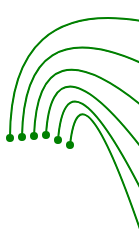With the transition to system-dynamic methods, which determine the complexity of a system (here the EEG), such as entropy (https://en.wikipedia.org/wiki/Entropy), the fractal dimension (https://en.wikipedia.org/wiki/Fractal_dimension) as well as the Lyapunov exponent (https://en.wikipedia.org/wiki/Lyapunov_exponent), one enters a completely new field for the investigation of EEG signals. All of the above-mentioned variables determine the complexity of the system. In our case of the system of a certain amount of EEG signals reflecting the electrically measurable brain activity on the surface of the head, the complexity concerns the irregularity or predictability of a signal. A sinus curve is just as predictable as a superposition of various trigonometric functions. These are very predictable and in no way irregular.
The irregularity of EEG signals can be determined in different ways. The Higuchi Fractal Dimension (HFD) measures the “crimpiness” or smoothness of a signal as a curve. This is similar to the way it was done in classical chaos theory, for example with coastlines (Norway, Britain, Scotland). The change of the coastline in Norway is much more difficult to predict from its course than the coastline in France south of Bordeaux. It is similar with an EEG signal. The more irregular it is, the higher its complexity and the higher its fractal dimension as well as entropy.
As described under the menu item “Results”, the mean values of the multiscale sample entropy (MSE) were determined for one group of AD patients and one group of healthy control subjects for 16 electrodes each. The MSE measures on different time scales the probability that sets of patterns that are similar for a number of data points are still similar one data point ahead. A higher complexity in the patterns is expressed here in higher values of MSE. With the exception of the highest time scales, the HC group showed higher values of MSE than the AD group, which can be used to distinguish between Alzheimer's patients and healthy individuals.
When applying the entropy measure to schizophrenia patients, the EEG signals are found to be more complex than in the healthy control group. The entropy measure is very useful for monitoring, e.g., to determine the depth of anesthesia or the effectiveness of certain sedative drugs, as well as for the correct determination of comatose states or brain death. Entropy would also be interesting for predicting epileptic seizures. There is already a great deal of work on this.
If you relate this to statistical physics, an increase in entropy often brings to mind an increase in disorder. How can this be consistent with an increase in the complexity of the EEG? The key lies in the notion of unpredictability associated with entropy, which can also have pathological features as in the example of schizophrenia. Conversely, in Alzheimer's patients “the discussion of the brain parliament is over”, as Prof. N. Birbaumer (University of Tübingen) graphically illustrated the brain activity.
At the same time, the occurrence of the dangerous p-tau protein (in Alzheimer's patients already in the preclinical stage) is linked to the disturbance of the circadian sleep rhythm and disrupts this rhythm and the function of GLS (Holth & Fritschi, 2019, source in “The role of sleep & EEG”). As a consequence, the synchronisation of local clusters is disturbed during sleep (and also during the day), i.e. the precise synchronicity, which is also expressed in the disturbed coherence of the RSN (resting state network), but is globally characterised by a continuously reduced entropy (for each electrode - but differently).
Indeed, it is the myriads of different synchronisation events that represent the micro-states of the “functional system brain”. Therefore, the idea of synchronization is taken as a starting point for the sum W of the microstates, which determines the entropy S over S = K · ln W.
With AD, this sum W of the synchronizations continuously decreases over time and thus also the entropy! This is the reason why MSE measures the degree of AD progression in EEG (and also e.g. in MCI as opposed to HC and AD). The fractal dimension of the EEG is methodically here only a synonym for entropy, which is the central variable to determine the complexity of the EEG.
The complexity of the EEG signal decreases because the complexity of the brain functions decreases due to the destruction of the neurons and the associated loss of synchronicity.
In general, pronounced brain activity increases complexity and increases entropy (more microstates = synchronization of firing neurons with PAC = phase amplitude coupling), so it is good against AD. Therefore, all activities of AD patients that aim at increasing brain activity, be it memory training, music therapy, games of any kind that train memory, are suitable to counteract cognitive decline. Completely counter-indicative, on the other hand, are drugs that have a sedative and drive-reducing effect, since this also undermines the drive to learn new things, which would be so important for many patients.
Synchronicity and its loss is currently the subject of intensive research. This concerns both the correlation of the activities of different neuron groups in the two brain hemispheres (laterality) and the application of graph-theoretical concepts, see https://en.wikipedia.org/wiki/Graph_theory, as well as physical signal analysis at the level of coupling of the phases of linked EEG signals. We will discuss these developments in more detail at the appropriate time, especially if we have our own research results available. In order to be able to understand these complex interrelationships, a multitude of intelligent analyses of the EEG must be implemented, taking into account the variety of information channels (EEG channels). In addition to the well-known multivariate procedures, we also use advanced methods of time series analysis.


 English
English  Deutsch
Deutsch